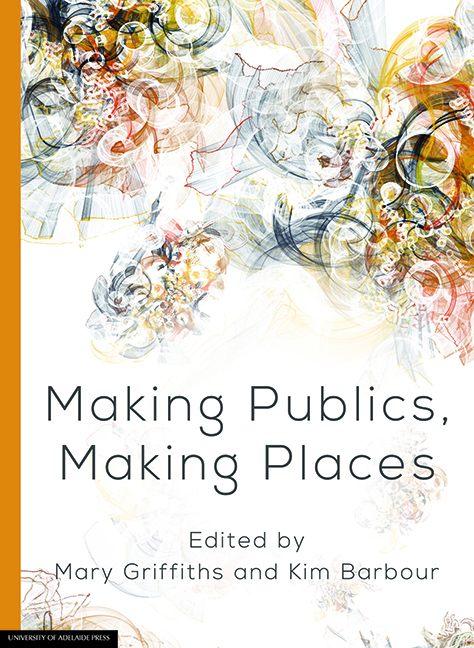Book contents
- Frontmatter
- Contents
- Preface
- Abstracts
- List of contributors
- 1 Making publics, making places
- 2 The elasticity of the public sphere: Expansion, contraction and ‘other’ media
- 3 ‘Imagine if our cities talked to us’: Questions about the making of ‘responsive’ places and urban publics
- 4 Picturing placelessness: Online graphic narratives and Australia's refugee detention centres
- 5 Reclaiming heritage for UNESCO: Discursive practices and community building in northern Italy
- 6 Find your Adelaide: Digital placemaking with Adelaide City Explorer
- 7 Chinese films and the sense of place: Beijing as ‘Thirdspace’ from In the Heat of the Sun to Mr Six
- 8 Social media and news media: Building new publics or fragmenting audiences?
- 9 The use of Chinese social media by foreign embassies: How ‘generative technologies’ are offering opportunities for modern diplomacy
- 10 An opinion leader and the making of a city on China's Sina Weibo
- 11 Public audiencing: Using Twitter to study audience engagement with characters and actors
- 12 Overcoming the tyranny of distance? High speed broadband and the significance of place
6 - Find your Adelaide: Digital placemaking with Adelaide City Explorer
Published online by Cambridge University Press: 28 July 2017
- Frontmatter
- Contents
- Preface
- Abstracts
- List of contributors
- 1 Making publics, making places
- 2 The elasticity of the public sphere: Expansion, contraction and ‘other’ media
- 3 ‘Imagine if our cities talked to us’: Questions about the making of ‘responsive’ places and urban publics
- 4 Picturing placelessness: Online graphic narratives and Australia's refugee detention centres
- 5 Reclaiming heritage for UNESCO: Discursive practices and community building in northern Italy
- 6 Find your Adelaide: Digital placemaking with Adelaide City Explorer
- 7 Chinese films and the sense of place: Beijing as ‘Thirdspace’ from In the Heat of the Sun to Mr Six
- 8 Social media and news media: Building new publics or fragmenting audiences?
- 9 The use of Chinese social media by foreign embassies: How ‘generative technologies’ are offering opportunities for modern diplomacy
- 10 An opinion leader and the making of a city on China's Sina Weibo
- 11 Public audiencing: Using Twitter to study audience engagement with characters and actors
- 12 Overcoming the tyranny of distance? High speed broadband and the significance of place
Summary
A perfect storm of opportunity
Digital, mobile and social technologies are transforming the possibilities for place-based engagement and interaction. The rapid informating of public places and spaces offers many new ways to change how we encounter, explore and respond to place. A cluster of technology-based innovations — including smart phones, wireless connectivity, high speed broadband, GPS, cloudbased computing, mobile applications and social media platforms — bring into play many new potential combinations of content, interactivity and context of use. The emergence and co-mingling of these technologies create the conditions for a perfect storm of radical innovation, a step change in the relationship between people and place. For organisations and individuals interested in the interpretation of place, this creates vast opportunities and a complex conundrum of choices. The experience of place can now be mediated through a bewildering variety of digital content, devices and interactions that have enormous potential to change perceptions, interest and involvement.
For those with a commitment to the conservation of urban environments and their social and historical associations, the idea of heritage has been a guiding concept for advocating and promoting the preservation of our built and natural environments. Heritage and heritage places may be defined in different ways, but generally what distinguishes them in the environment is their recognised significance as sites of aesthetic, cultural, historical, scientific or technical interest. More simply, heritage may be defined broadly as those things that we preserve from the past for the future. For more than 120 years, organisations such as the National Trust have sought to raise awareness of the natural and built environment around us and to encourage an interest in conserving the physical fabric, natural systems, stories and cultural values of heritage places. The recent emergence and confluence of digital technologies and their rapid uptake present a unique opportunity to promote heritage conservation in the digital age.
Signifying significance
The recognition and documentation of places deemed to hold heritage significance is an ancient practice. In promoting significant places, we have also transcribed the stories of the past onto the landscape with memorials, monuments, markers and signage.
- Type
- Chapter
- Information
- Making Publics, Making Places , pp. 95 - 110Publisher: The University of Adelaide PressPrint publication year: 2016



